And suddenly spring is here! I won’t pretend that I was too active in the garden over the winter, but the garden seems to be doing fine all the same. Buds and blooms and freshly emerging greenery abound, with lots of pollinators and birds and other critters keeping the garden in constant motion.
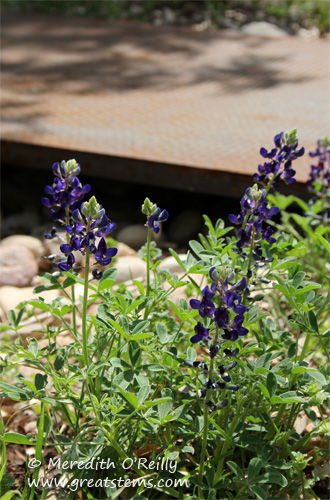 Out by the new dry creek bed, the bluebonnets are in bloom. I am ever so happy I planted these along the street — what a cheery and very Texan way to greet the neighbors. We continue to be very pleased with our creek bed — it is such a visual improvement over the trench that once was there. It looks like most of the other plants along the creek have made it through the winter — once they are a little bigger, I’ll give a report on the different species we planted.
Out by the new dry creek bed, the bluebonnets are in bloom. I am ever so happy I planted these along the street — what a cheery and very Texan way to greet the neighbors. We continue to be very pleased with our creek bed — it is such a visual improvement over the trench that once was there. It looks like most of the other plants along the creek have made it through the winter — once they are a little bigger, I’ll give a report on the different species we planted.
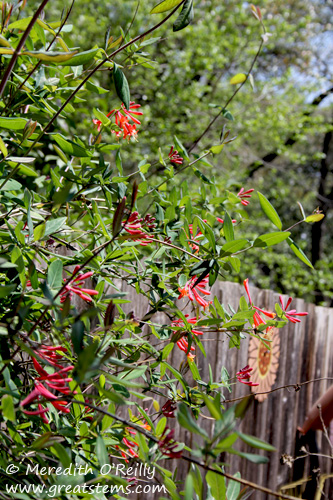 In the backyard, the Coral Honeysuckle is so dense and tall that I think this year it will finally spill over the fence.
In the backyard, the Coral Honeysuckle is so dense and tall that I think this year it will finally spill over the fence. 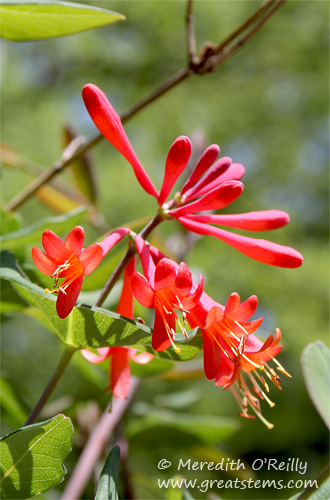 Hopefully my neighbor will enjoy the blooms — he loves color in the garden.
Hopefully my neighbor will enjoy the blooms — he loves color in the garden.
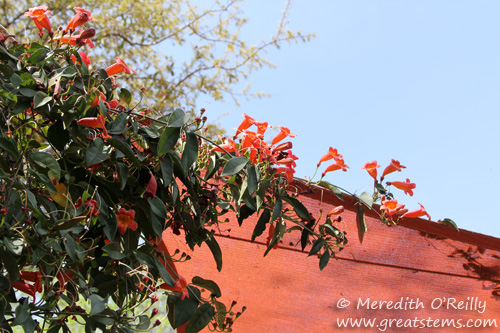 The Crossvine near the backyard shade sails is heavy with blooms (there were even more blooms a couple of days ago, but in typical fashion I forgot to put the memory card in the camera when I took pics that day — alas). We love the creeping vines and blooms working their way along the edge of the sails.
The Crossvine near the backyard shade sails is heavy with blooms (there were even more blooms a couple of days ago, but in typical fashion I forgot to put the memory card in the camera when I took pics that day — alas). We love the creeping vines and blooms working their way along the edge of the sails.
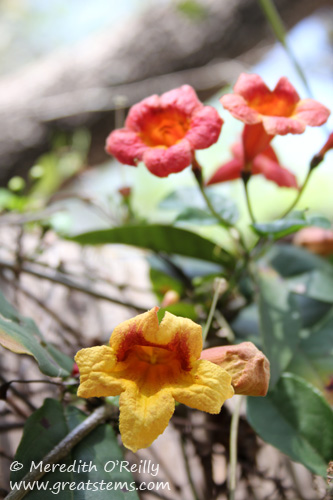 But here’s a mystery — over in the shade my original Crossvine plant, the native yellow-exterior variety, is doing something odd. Part of it is blooming yellow as expected, but the same plant is simultaneously producing orange-exterior blooms. What on earth is going on? There hasn’t been any change to the soil, but we did have a very mild winter — is it a temperature thing? I don’t want to lose my yellow blooms — they are my favorite! I’m trying not to feel alarmed, but I can’t help it!
But here’s a mystery — over in the shade my original Crossvine plant, the native yellow-exterior variety, is doing something odd. Part of it is blooming yellow as expected, but the same plant is simultaneously producing orange-exterior blooms. What on earth is going on? There hasn’t been any change to the soil, but we did have a very mild winter — is it a temperature thing? I don’t want to lose my yellow blooms — they are my favorite! I’m trying not to feel alarmed, but I can’t help it!
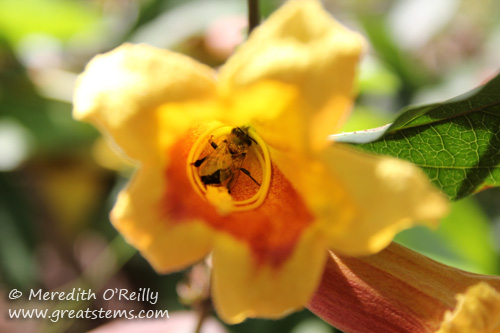 The honeybees don’t seem to mind the change — they visit the yellow and orange blooms with equal interest.
The honeybees don’t seem to mind the change — they visit the yellow and orange blooms with equal interest.
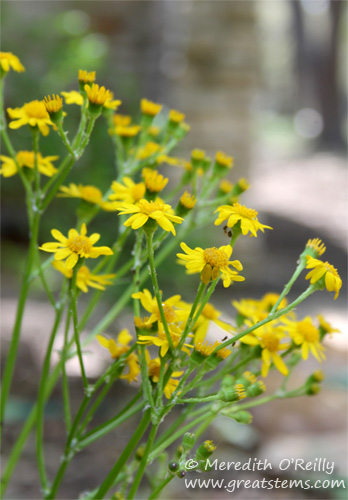 This year, I’m excited to see my Golden Groundsel blooming for the first time. Let’s hope it reseeds and makes babies.
This year, I’m excited to see my Golden Groundsel blooming for the first time. Let’s hope it reseeds and makes babies.
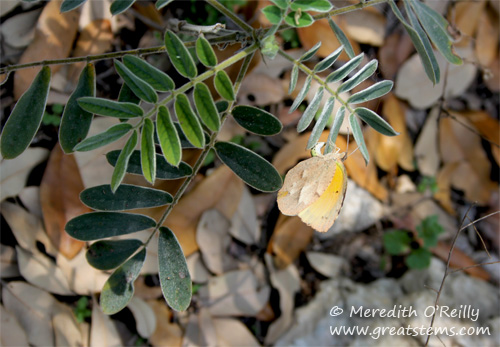 Sulphur butterflies, several species of them, have been busy laying eggs all over the Lindheimer’s Senna, which has barely had a chance to really show its spring face. But that’s par for the course — it’s the host plant for many Sulphur species, such as Sleepy Orange, Cloudless, Southern Dogface, Large Orange, and others. Eggs dot the tops and bottoms of the leaves — I can’t wait to see the caterpillars. I’m not worried about the number — I’ve got plenty of Lindheimer’s Senna to go around. I’ve never seen this many Sulphurs in the yard — can you guess how much I’m loving it? Lots!
Sulphur butterflies, several species of them, have been busy laying eggs all over the Lindheimer’s Senna, which has barely had a chance to really show its spring face. But that’s par for the course — it’s the host plant for many Sulphur species, such as Sleepy Orange, Cloudless, Southern Dogface, Large Orange, and others. Eggs dot the tops and bottoms of the leaves — I can’t wait to see the caterpillars. I’m not worried about the number — I’ve got plenty of Lindheimer’s Senna to go around. I’ve never seen this many Sulphurs in the yard — can you guess how much I’m loving it? Lots!
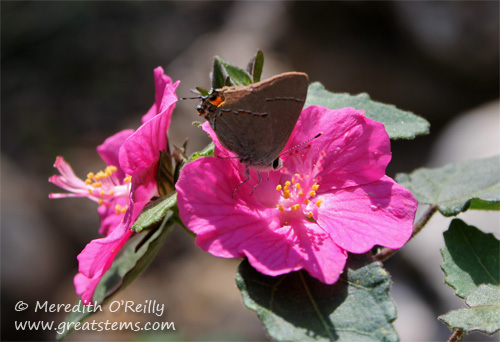 Gray Hairstreaks are visiting the garden, as well — this one on Rose Pavonia. Every time I see one, I think about how scientists are realizing that spiders might play an important part in the defensive coloration of butterflies (birds had long been considered the primary suspects involved). The “head” at the tip of the butterflies’ wings is a visual distraction, and small predators such as jumping spiders mistakenly aim for the wing tip instead of the actual head of the butterfly, which means the butterfly has a chance to escape. The same false head is less effective against birds, it turns out.
Gray Hairstreaks are visiting the garden, as well — this one on Rose Pavonia. Every time I see one, I think about how scientists are realizing that spiders might play an important part in the defensive coloration of butterflies (birds had long been considered the primary suspects involved). The “head” at the tip of the butterflies’ wings is a visual distraction, and small predators such as jumping spiders mistakenly aim for the wing tip instead of the actual head of the butterfly, which means the butterfly has a chance to escape. The same false head is less effective against birds, it turns out.
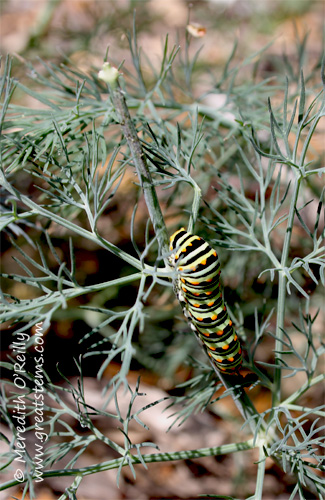 I was thrilled to discover that our dill and fennel are covered in Black Swallowtail caterpillars. In the fall I decided to be brave and plant the dill in one of the main garden beds, deciding that I’d be okay if it reseeds to abundance (the fennel is in its own container). Given my delight over the caterpillars, I feel confident that I made the right choice. But of course, we’ll see how much dill shows up next year!
I was thrilled to discover that our dill and fennel are covered in Black Swallowtail caterpillars. In the fall I decided to be brave and plant the dill in one of the main garden beds, deciding that I’d be okay if it reseeds to abundance (the fennel is in its own container). Given my delight over the caterpillars, I feel confident that I made the right choice. But of course, we’ll see how much dill shows up next year!
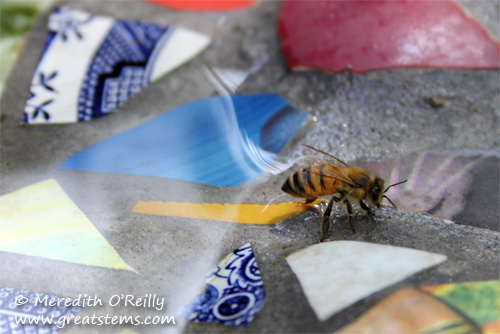 The mosaic birdbath is popular, and not just with birds. Squirrels and bees visit it, too — and who knows what else. It was fascinating watching the bees today — some collected water by skimming over the surface for a quick drink, but others preferred to stand on the side and drink safely at their leisure.
The mosaic birdbath is popular, and not just with birds. Squirrels and bees visit it, too — and who knows what else. It was fascinating watching the bees today — some collected water by skimming over the surface for a quick drink, but others preferred to stand on the side and drink safely at their leisure.
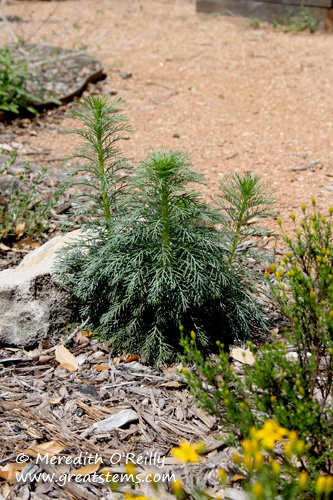 I’ve got many Standing Cypress plants now in their second year, and the flower spikes are already on their way up. They will grow big and tall by the time they are ready to show their vibrant red flowers — which the hummingbirds will go crazy for!
I’ve got many Standing Cypress plants now in their second year, and the flower spikes are already on their way up. They will grow big and tall by the time they are ready to show their vibrant red flowers — which the hummingbirds will go crazy for!
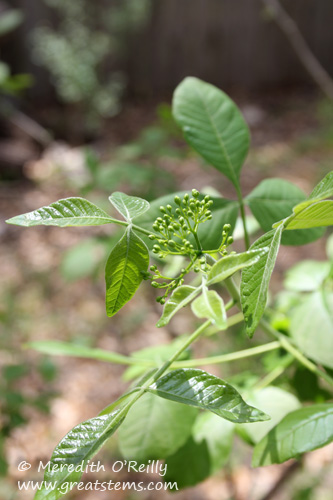 The Wafer Ash is even closer to blooming. With luck, I’ll actually see the flowers this year (usually they are sneaky, and the blooms come and go before I notice).
The Wafer Ash is even closer to blooming. With luck, I’ll actually see the flowers this year (usually they are sneaky, and the blooms come and go before I notice).
Despite all the blooms, the garden is still in a state of transition. From a distance, many of trees and shrubs still look somewhat bare as the buds emerge, while others are already fully green and working on their flowers. That’s okay — it’s still early in the season, and all I care about are that things are growing and alive. I’m a pleased gardener.
She’s back! And with a wowser of a report. Beautiful pictures and great new info – to me – on spider’s effect on butterfly evolution.
And the spider info seems so obvious now, doesn’t it? A bird would be less likely to care about that marking, but a small jumping spider? Would totally fall for it, I’d expect.
Looking lovely, Meredith! I look forward to more pics of your dry creek plantings now that I’ve seen that area in person. 🙂
Will do, Pam! Just letting them get a little bigger.
Very cool! I still have to plant copious amounts of milkweed…and I think I’m going to have to go about saving butterflies this year (it seems we end up with an inordinate amount of wasps that find the caterpillars delicious).
The first year we focused on butterfly gardening, we had a higher wasp population, too. I do still prefer to protect my monarchs by raising them in the cat houses, even though everything is more in balance, now. I just feel that monarchs need extra help!
Did a double take when I read “cat houses” thinking “what wonderful thing has she come up with now?” … then I realized it was the amazing caterpillar house I already covet so. Great to see what’s going on and the evolution of the dry creek.
I guess I should be more careful to write out “caterpillar” in the future!
I like the way you have a short amount of great informational copy relating to the photo. Great photos too. Nice
Thanks, Vernon! I strive to share info about my favorite natives — gets the message out!